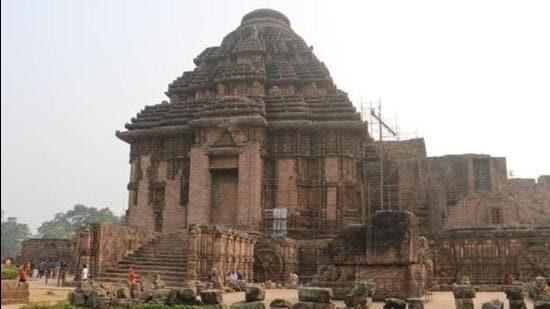Possible neotectonic activity behind collapse of Konark Temple: IIT researchers
The exact date and reason for the collapse of the Konark Temple is shrouded in mystery. Even though it is difficult to ascertain how long the temple stood the test of time, there are many speculations on this.
KOLKATA: The main portion of the 13th century Konark Temple in Odisha, a UNESCO World Heritage site, may possibly have collapsed due to involvement of some neotectonic activity, a team of researchers from the Indian Institute of Technology Kharagpur has suggested.

The researchers claim that even though there are multiple speculations about how the main portion of the temple collapsed, this is for the first time that they have got some scientific evidence to suggest that tectonic movement may have led to the collapse of the temple.
The massive temple dedicated to the Sun God was built by King Narasimhadeva-I of the Ganga dynasty between 1243 and 1255. It is one of the most popular tourist spots of the eastern state.
The temple as seen today is actually the Jagamohana (assembly hall) of the actual temple. The main temple tower, known as Garbha Griha, which enshrined the presiding deity has collapsed and only the remains can be seen.
“There are many theories and speculations about how the main temple collapsed. But none could be proved scientifically. Our study looks at this old historic problem from a geological perspective. The findings reveal that neotectonic activity may have been responsible for the collapse of the earlier temple structure,” said William Kumar Mohanty, a professor of department of geology and geophysics at IIT Kharagpur.
Earlier in 2016, the same team found evidence of the extinct Chandrabhaga River near the UNESCO world heritage site. The researchers took the help of satellite images and then validated it with other field data to trace the paleochannel of the ancient river.
Odisha’s coastal region is undergoing tectonic activity even today as a result of reactivation of the faults which crisscross the basement of the Mahanadi delta.
The subsidence and uplift of basement blocks is responsible for morphological changes along the trajectories of the river channels flowing through the coastal region. These tectonic movements are likely to have disrupted any existing river flowing along the fault planes and may be one of the causes for the drying of many river channels, including the ancient Chandrabhaga River passing north of the Konark temple.
“Low to moderate magnitude earthquakes in this region, which lies in seismic zones II and III, indicate significant slow movement on basement faults (tectonic creeps) most likely as a result of the northward movement of the Indian plate. Collapse of the Konark Sun Temple is likely linked to neotectonic activity in this region” said Saibal Gupta, professor of Department Ggeology and Ggeophysics at IIT Kharagpur.
The findings have been published in Journal of Earth Science System, a peer-reviewed journal brought out by the Indian Academy of Sciences. The four-member team comprising researchers Subhamoy Jana and Prakash Kumar was led by Mohanty and Gupta.
The exact date and reason for the collapse of the temple is shrouded in mystery. Even though it is difficult to ascertain how long the temple stood the test of time, there are many speculations on this.
The researchers said that some theories and their drawbacks were discussed in a book titled Suryakhetra Konark by Balaram Mishra.
One of the theories suggests that the structure of the temple was never completed because of the early death of King Langula Narasimha Dev. Another theory states that after the suicide of Dharmapada (son of Bisu Maharana, main engineer of the temple), the temple lost its sacredness and was subsequently abandoned by the devout, leading to the temple falling into a state of disrepair. Another common belief is that during construction of the temple, the interior and exterior of the temple was filled with sand and when the sand was removed the temple collapsed.
But there are researchers, who have a different opinion and claim that had there been a tectonic movement, other temples that are contemporary to the Konark Temple would have also been affected.
“The IIT team may have their own evidences but there are many other smaller temples in that area within a radius of 10 km. Take for example the Chaurasi Varahi temple and the Gangeswari temple. Both are contemporary to the Konark temple and are still intact and well preserved by the Archaeological Survey of India. Had there been a tectonic movement they all would have been affected,” said Anam Behera, assistant professor of ancient Indian history, culture and archaeology at Utkal University in Odisha.
The IIT team, however, said that the two faults located within 30 km from the surface of the earth intersect close to the Konark Temple. The ancient Chandrabhaga River too used to flow close to the temple. Hence, the loose sediment deposits below the temple would amplify any slow tectonic movement around these faults, affecting only the Konark Temple.
“There are indeed two faults close to the Konark Temple and tectonic movements centering around these faults might have possibly led to the collapse. The Lingaraja Temple in Bhubaneshwar and the Puri Temple were not affected because they were located far off. Tectonic movement is still going on in the area and in future even mild earthquakes may reactivate the faults which in turn could take a toll on the existing temple structure,” said Kabir Mohan Sethy, professor of geography at Utkal University.
Get Current Updates on India News, Ram Navami Live Updates , Lok Sabha Election 2024 live, Elections 2024, Election 2024 Date along with Latest News and Top Headlines from India and around the world.



